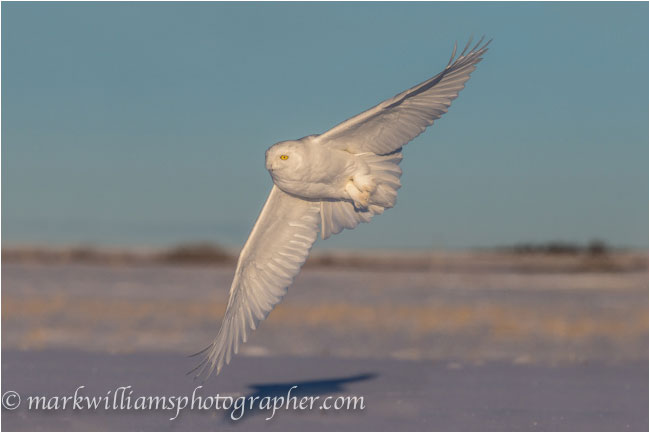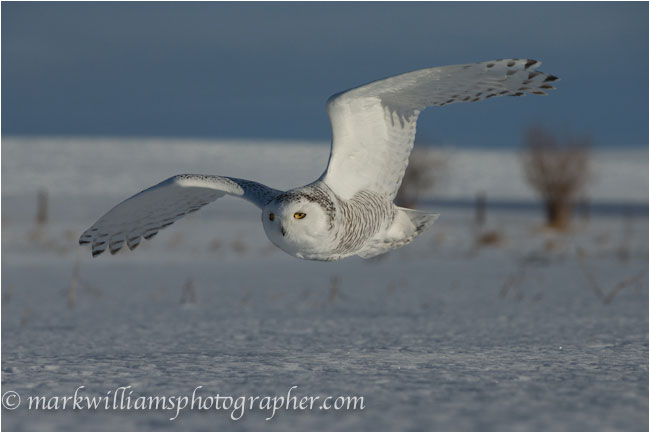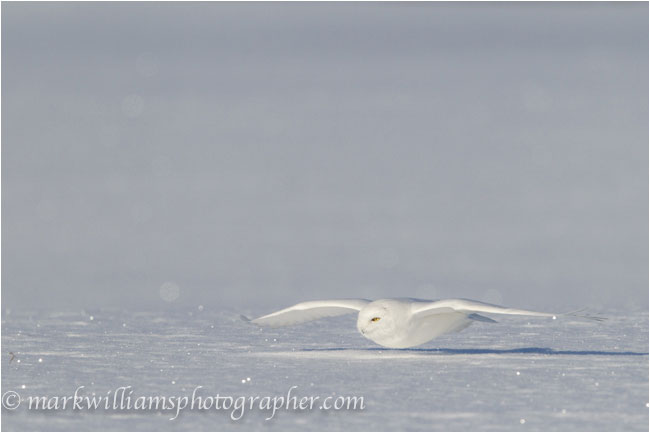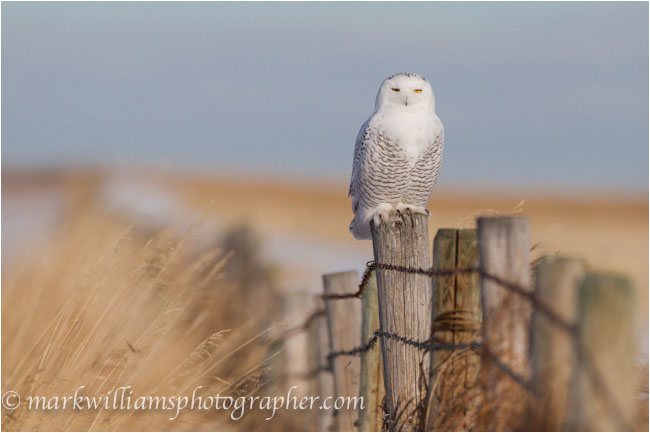
White on White – Finding, Identifying and Photographing
Snowy Owls In Winter
Article and Photographs by
Mark Williams
January 15, 2013

Adult female snowy owl
I would hardly call myself a winter aficionado but since we have 5 months of the white stuff I find myself making the most of the photographic opportunities it presents. To the untrained eye there is not a lot to photograph in our bleak winters compared to our other 3 distinct seasons. This being said, in spite of the fact most of our bird life has migrated south and some of our mammals go into hibernation, I find winter is full of photographic opportunities that do not exist at any other time of the year. Add to this the fact the sun is low in our northern hemisphere and taking advantage of the amazing gentle light of early dawn or sunset all adds to some pretty incredible photographic opportunities.
Up close and personal - snowy owl sitting on the ground at sunset
During our Canadian winters few spectacles are more eagerly anticipated than the invasion of the snowy owls. They breed near the artic regions of North American and Eurasia and they can make unpredictable movements south of their normal winter ranges. On this continent they normally spend winter across central Canada and Alaska and the northern parts of the great plains and Great Lakes. I’ve spent the last 4 winters studying snowy owls and have managed to capture several thousand images of them.
Some years we see spectacular mass movements south, or “irruptive” years as they are referred to and media reports reveal they have strayed as far south as Texas and Florida in significant numbers at times. These population irruptions are cyclic and studies have shown they are linked with the breeding success of lemmings, their staple diet during nesting season although they are also known to eat other small rodents and rabbits as well as ducks, geese and shorebirds. Likewise it is theorized that a crash in their main prey species along with a particularly harsh winter is the cause for them to be driven so much further south than they are normally found as competition for food becomes fierce.
This past winter was the second year in a row that we have seen great numbers of snowy owls in southern Alberta where I live. They are most commonly found east of Calgary area from Irricana to east of Nanton and on a good days drive we’ve sen a dozen or more owls. These winter migrations create an ideal opportunity for local wildlife photographers like myself to capture some great images of these magnificent birds. Most of the time they are to be found on top of power poles but to the trained eye are often seen on a high point out in the middle of a snow covered field sitting on the ground. Many of my fellow photographers are happy to find and photograph them but I’ve found few who are able to identify the sex and age of the birds. Although not always a guarantee, in adult birds the pure white birds are males and the larger females are the more heavily marked birds. This being said it is difficult to distinguish when looking at sub adult birds, particularly if they are not stood side by side. The following two images illustrate this clearly and they are both images of males but I’m sure you’ll agree they look quite different and most novices would say the one with spots is a female.
Sub adult male unexpectedly landing nearby. Taken with 600mm hand held
Pure white adult male in low glide
The most heavily barred owls from nape (neck area) to their tail and belly are the sub adult females. Adult females have spots on their crown and moderate to extensive dark markings on their wings, nape, breast and tail.
I recommend a good pair of binoculars as essential equipment in spotting and identify birds or a good quality spotting scope. Digi-scoping (the use of a digital camera to take photos through a spotting scope), is a popular way to get good close up pictures but are best for static subjects. My preference is a good quality digital SLR, the faster the frame rate the better. When matched with a long fast lens of focal lengths of 300mm or more, it is a perfect set up for getting that exciting action shot many of us strive for.
Up close and personal - female snowy owl
Photographing these birds can be difficult and like many facets of photography there are a million ways to go about it which in turn also serves to bring out the creativity within us. However I’m not just referring to knowing and understanding your equipment, which all of us should, but instead I am talking about knowing and understanding your subject that few photographers make the effort to learn. This is what I feel distinguishes the ordinary from the great photographers and ultimately reflects in their results.
Obvious female - Dark Nape and heavily barred front and tail
As we know all wild animals have a genetically hard-wired predisposition to take flight by wing or foot if they feel threatened. Some species are more nervous than others and therefore call for different approaches. As mentioned, learning and knowing your subject intimately will help you get the best results but most of this knowledge comes from field experience and to some extent your ability to recognize those more subtle signs and behaviors. At times I use a camo blind to observe and photograph an animals natural behavior but for snowy owls there is little or no time to set up and you must act quickly to seize an opportunity but yet move slowly so as to get close enough without disturbing them. Yet in spite of this it is often possible to get close to your subject when done the right way and minimizing any pressure you put upon the subject. This includes subtle actions like not looking directly at the subject and avoid making eye contact and also taking periodical pauses to gauge the subject’s reactions to your approach and proximity. If I sense tension I wait and let the bird relax before I move again. The trick is learning when you’ve reached the limit. It is not uncommon for me to be seen minimizing my profile by crawling for 20 minutes on my belly in cold wet snow for an eye level perspective of an owl on the ground.
Getting the shot - Mark Williams on the ground photographing a snowy owl in flight
I relish all wildlife photography but it is widely accepted that birds in flight is a particular skill unto itself. Tracking a fast moving small object like birds in flight pushes the limits of both photographer and camera in equal measures. All cameras require contrast to work and grab focus, let alone lock onto a fast moving white owl on white snow! Even with the very best of equipment, in certain light conditions it is virtually impossible and your “keeper rate” will drop significantly. I prefer to use a fast 300mm F2.8 lens for birds in flight, although I have used both wide angle and super-telephoto lens’s for different desired effects.
Female taken using a 17-40 mm wide angle lens
Adult male taking off, taken with 600 mm hand held
Some shooting situations require the reach of a super-telephoto like a 500mm and 600mm lens both of which I have used with great results and I shoot hand-held 95% of the time. It takes good technique and some getting used to, but it is invaluable in getting those special shots that a monopod or tripod topped with a gimbal head takes valuable time to set up initially and simply just can’t maneuver quick enough, particularly with a bird whizzing by at 45 miles per hour often in an erratic, unpredictable movement. For flight shots I try to always keep shutter speed above 1600th sec and F stop between F5.6 and F8 depending upon available light, unless I intend to deliberate create a blurred effect. Most modern digital SLR’s have good ISO performance to help you with this but on sunny days during winter with the reflection of the snow it is not uncommon to be able to shoot lower ISO’s at 4000th sec at F7.1, depending upon your desired intended result.
Adult male skimming the ground
Because I want total control over my image, I shoot manual mode most of the time and will use spot focus and most often center weighted metering. Some cameras will allow for an acute spot center focus or heavily weighted center group and I prefer that for birds in flight as opposed to using the full 61 focusing points available in a Canon 1DX for example. My initial belief when years ago when buying my first pro-body camera was that the more the focusing points the greater my chances of keeping the subject in focus. In theory it sounds good and maybe for a large subject like an athlete or racing car yes, but practical experience with small unpredictable and fast moving wildlife it proved otherwise. Murphy’s law one of those peripheral focusing points grabs a twig or blade of grass as your tracking and takes the focus off your subject during the pace and excitement of following the fast moving bird or animal. A lot depends upon the make/model and features of your particular camera but for best results I use the center focusing points and try keep tracking the focus point on the target. Easier said than done I know …but practice makes perfect! As a tip, go to a city park or public place where pigeons, gulls or ducks can be found and practice there.
Female snowy owl hunting
Our wildlife has to endure everything mother natures throws at it and likewise some days our harsh Canadian winter weather presents conditions that keep all but the die hard photographers at home. In order to get some unique yet very natural images you just have to roll with the punches and I have taken some of my more unique images crawling on my belly in bitter frigid -25°C temperatures combined with 60km per hour blowing snow that I would not have got if at home sitting on the sofa. Of course I would not have got frost bite either !
Adult female snowy owl, -24°C with 60 km per hour winds
Immature Male on fence post white nape, white bib and subtle barred front
Same (immature male) as on fence post, white nape (visible), white bib and subtle barred back
I am fascinated with all birds of prey and snowy owls have captured my attention from the first time I saw them, all be it initially in captivity some 30 years ago. Today I count myself fortunate to now be able to view and photograph them in their natural environment and to share some of the results with others to help motivate a greater appreciation of them and many other magnificent creatures through the art of photography.
 |
Mark Williams considers himself a serious amateur wildlife photographer whose real job (that supports his passion), is in retail management. Although Mark has only seriously been photographing wildlife for the past 5 years, his work has been published in various books, magazines and even music album covers and a selection can be seen in his website: markwilliamsphotographer.com
|
Related Articles & Resources
- Birds of prey in flight and other wildlife photography by Mark Williams
- White Ghosts of the Prairies - Photographing Snowy Owls Near Calgary by R. Berdan
- White Ghosts of the Prairies - Photographing Snowy Owls Part II Mossleigh, Alberta by R. Berdan
- The "Owl King Dr. Wayne Lynch Canada's Wildlife Specialist by R. Berdan
- Snowy Owls of Boundary Bay, BC by Jon Huyer
- Birds Calgary - Snowy owl sightings
- How to Photograph Birds in Flight by R. Berdan
[ Top ] |












